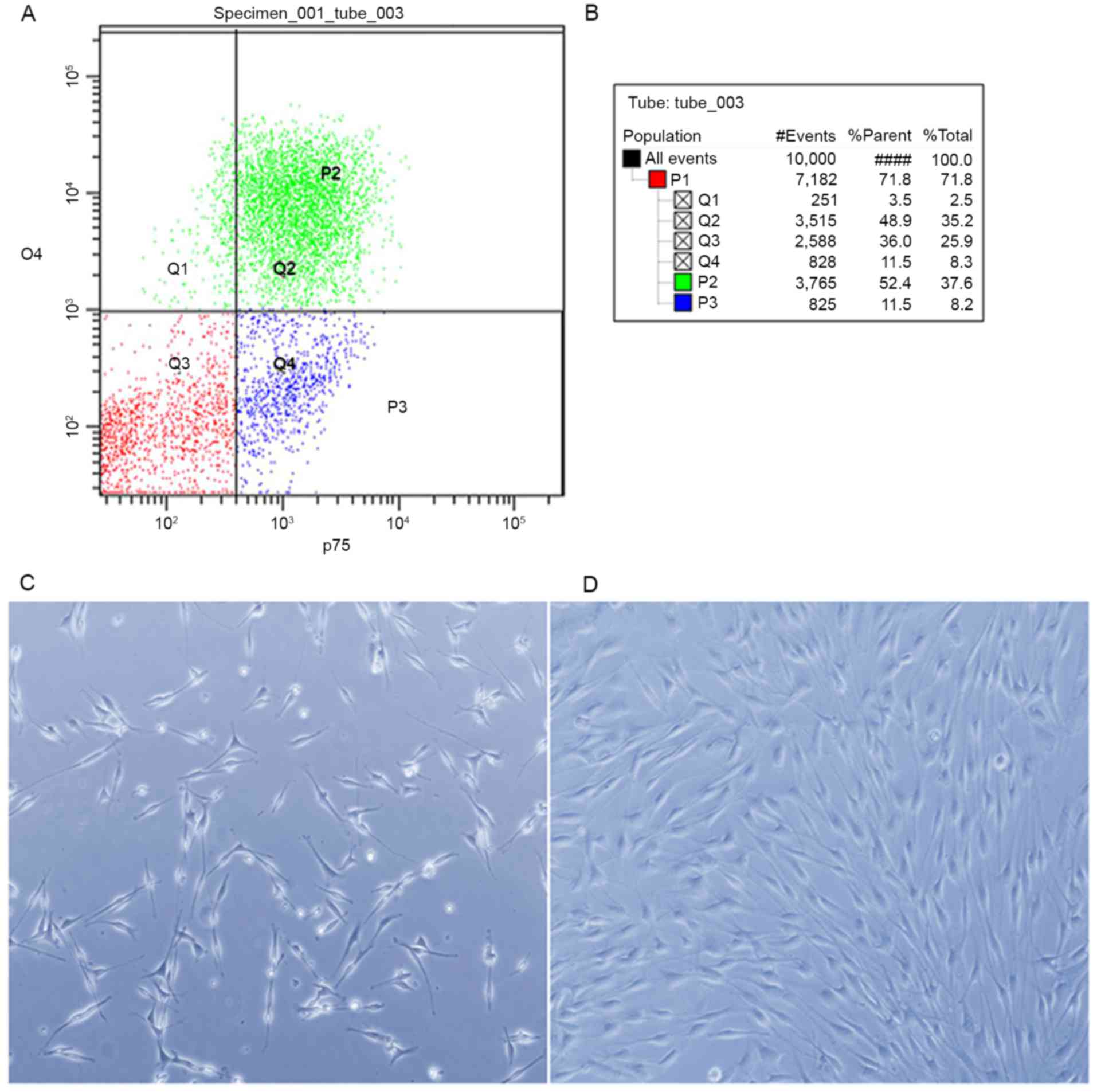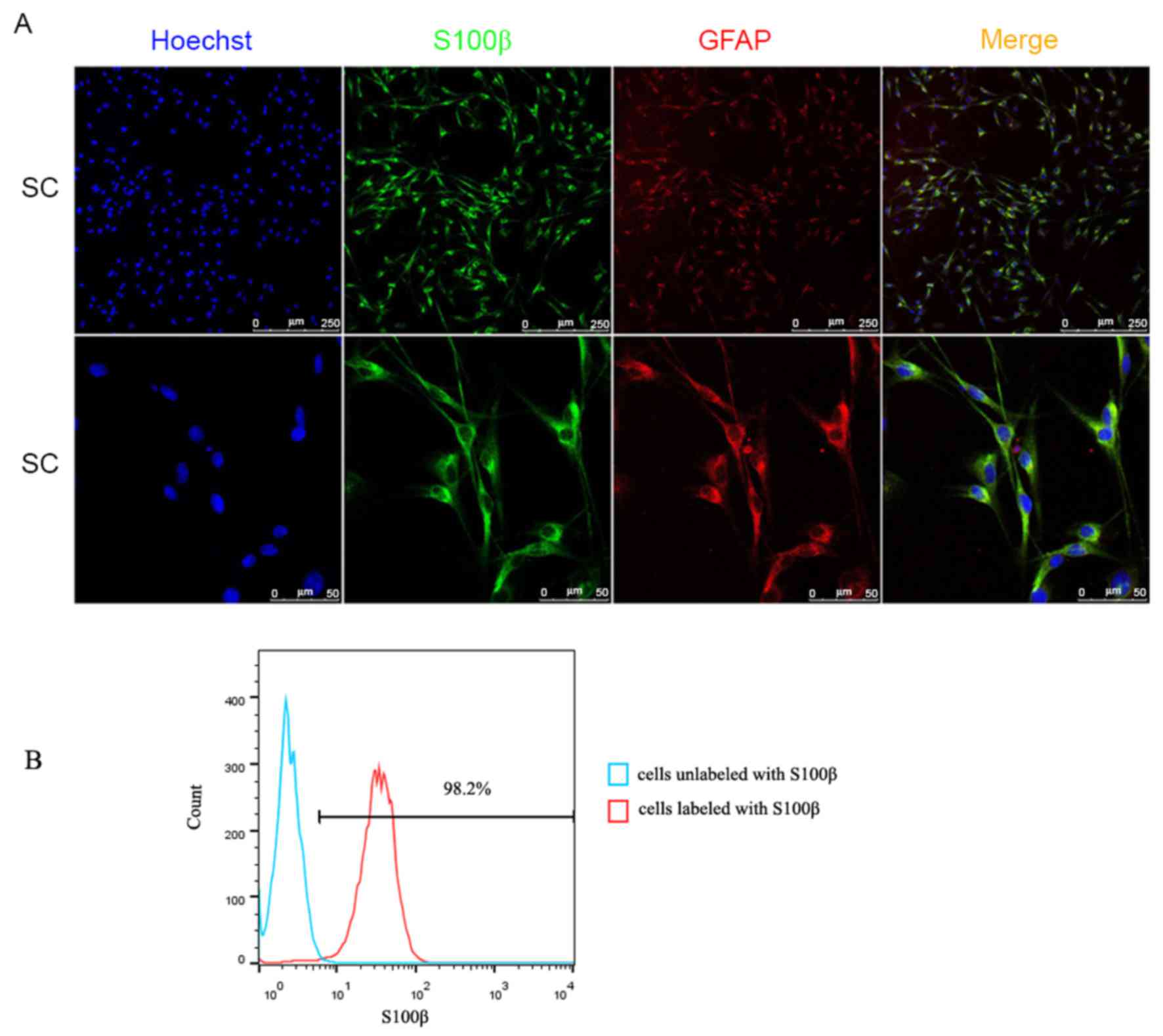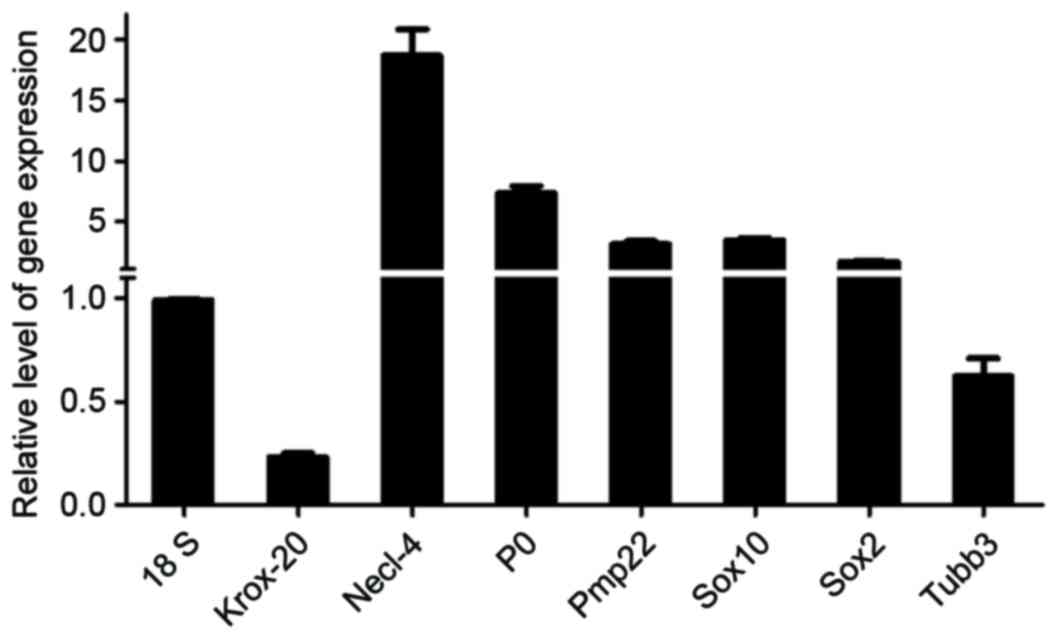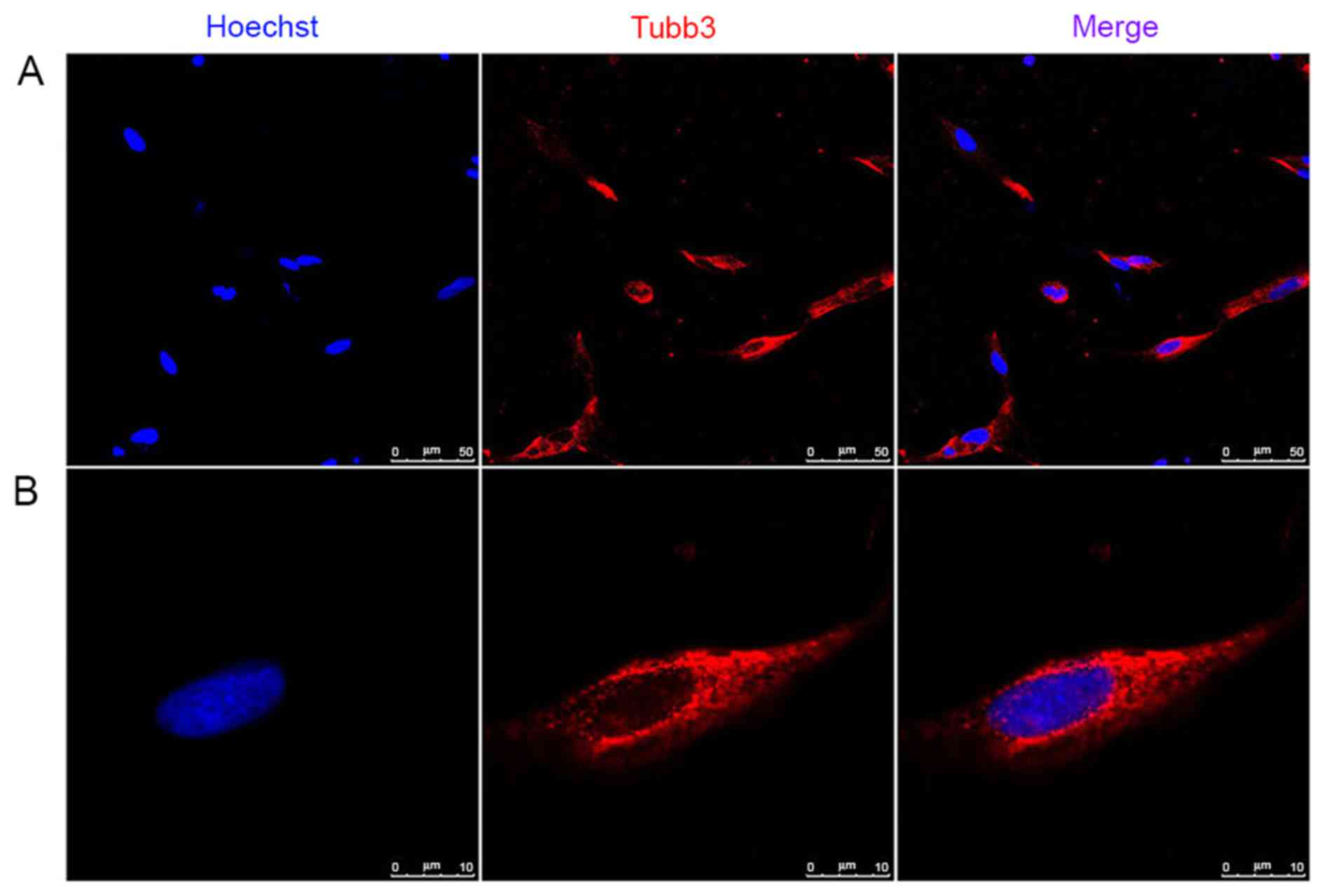Isolation of rat Schwann cells based on cell sorting
- Authors:
- Published online on: June 14, 2017 https://doi.org/10.3892/mmr.2017.6777
- Pages: 1747-1752
-
Copyright: © Shen et al. This is an open access article distributed under the terms of Creative Commons Attribution License.
Abstract
Introduction
Rats are widely used in experiments based on surgery, as it is easier to perform surgery in rats, including spinal cord injury (1), peripheral nerve system injury (2) and brain injection (3), compared with mice. Certain experiments examining nerve injury in young models require cells from newborn and young rats. It is easier to perform surgery on newborn rats than mice, for example in the establishment of models of brachial plexus injury (4). Schwann cells (SCs) are the principal glial cells of the peripheral nervous system (PNS) and are involved in a wide range of biological and pathological process. Tissue engineering of peripheral nerves and ex vivo gene therapy requires rat SCs of a highly purity (5). Primarily cultured rat SCs are essential for the investigation of molecular mechanisms regulating the proliferation, survival, differentiation and myelination of SCs (6,7). They are also useful for the development of efficient transplantation for the regeneration of injury to the spinal cord or PNS (6,7). In regenerative medicine approaches, the preparation of a highly-enriched SC population is required in SC transplantation (8). Minimization of the number of contaminating fibroblasts, which can affect the biological analysis and experimentation of SCs, and increase scar tissue formation, is required. For this purpose, the present study modified the techniques of several previously published protocols and developed a method for the isolation and enrichment of rat SCs from sciatic nerves (9–14).
A problem in preparing SCs is fibroblast contamination and the overgrowth of SCs by fibroblasts in long-term culture. Therefore, several methods exist to separately remove either fibroblast cells from the SC cultures or SCs from fibroblasts, as a form of purification (15). The use of antimitotic chemicals is a commonly used technique to inhibit fibroblast growth on the basis of the higher proliferation rate of fibroblasts (9). Furthermore, the preferential surface expression of Thy-1 by fibroblast cells can be exploited by using anti-Thy1 antibodies, in conjunction with complement-mediated cell lysis (16). Other selective purification methods include the use of magnetic beads labeled with low-affinity nerve growth factor receptor (p75NGFR) antibodies, with physical removal and subsequent isolation (12–17). Similarly, the use of magnetic beads labeled with Thy-1 antibody to remove fibroblast cells has been reported (18). Nonspecific purification methods are also common and include a ‘cold-jet’ technique, in which ice-cold culture medium is added to impure cultures followed by a rapid aspiration step (19,20). This method preferentially removes weakly adherent SCs whereas the more adherent fibroblast cells remain on the dishes. A method utilizing immunopanning to deplete macrophages and fibroblasts from the nerve cell suspension, and to positively select for SCs has also been used (21,22).
In order to examine the general biology of SCs, the present study aimed to achieve a method of harvesting SCs rapidly. Cell biology can be affected by a long duration of culture in vitro, chemicals, growth factors and serum. Therefore, the present study aimed to develop a simple protocol to generate highly purified rat SCs by cell sorting using p75 and oligodendrocyte marker 4 (O4), which resulted in 98% pure SC cultures. According to previous studies, p75 and O4 are used as markers for the isolation of SC (11,19,21,22). p75 is reported to be expressed in SCs, with the exception of myelinating SCs (23–25), whereas O4 is expressed in SCs, including myelinating SCs (23–26). p75 and O4 are surface markers, which enables labeling of living SCs and sorting of the cells. Therefore, the two antibodies can be jointly used to label SCs in vivo to obtain the maximum number of cells. Following sorting, SCs can be cultured in SC culture medium to stimulate cell growth and differentiation, or analyzed immediately. This method is potentially rapid, efficient and reproducible, thus facilitating SC isolation, and promoting SC-associated investigations and applications.
Materials and methods
Establishment of rat SC cultures for fluorescence-activated cell sorting (FACS) and following FACS
The sterile removal of sciatic nerves was performed on newborn rats (1–3 day old) housed in SPF conditions. The animals were supplied by the Experimental Animal Center of Nantong University (Nantong, China) and were maintained at 24°C with a 12-h light/dark cycle and a routine provision of food and water. All animal experiments were performed in accordance with the Industrial Animal Care Guidelines of Nantong University (Nantong, China) and approved by the Administration Committee of Experimental Animals (Jiangsu, China). The nerves were pooled and cut into 1 nm sections in Hibernate E (BrainBits, LLC, Springfield, IL, USA) containing 2% B27 (Sigma-Aldrich; Merck KGaA, Darmstadt, Germany) on ice. The tissues were then harvested by centrifugation for 5 min at 139 × g and 4°C. The supernatant was discarded and 1% collagenase (Gibco; Thermo Fisher Scientific, Inc., Waltham, MA, USA) was added and incubated at 37°C for 20 min, following which 0.125% trypsin (Gibco; Thermo Fisher Scientific, Inc.) was added and incubated for another 10 min. Digestion was terminated with DMEM (Gibco; Thermo Fisher Scientific, Inc.) and 10% fetal bovine serum (FBS; Gibco; Thermo Fisher Scientific, Inc.). Dissociation was achieved by mechanical dissociation through a 1-ml Pasteur pipette. The cells were centrifuged for 5 min at 210 × g, and 4°C. The cell sediment was rinsed twice using PBS and suspended in 0.1 M PBS for antibody labeling. Following FACS, the sorted cells were seeded onto dishes or slides in DMEM with 10% FBS and 1% penicillin/streptomycin in a 37°C, 5% CO2 incubator and cultured for 4 h. Then, the culture medium was replaced with SC culture medium consisting of DMEM with 10% FBS, 1% penicillin/streptomycin, 2 µM forskolin and 10 ng/ml HRG (both from Sigma; Merck KGaA) and the cell culture was maintained subsequently in a 37°C, 5% CO2 incubator for 24–48 h.
Coating cell culture surfaces
At 24 h prior to seeding of the SCs, plastic or glass surfaces were coated with poly-L-lysine (Sigma; Merck KGaA) and incubated for 30 min at room temperature. The dishes and slides were rinsed three times with sterile water, dried naturally and then stored at room temperature until use.
Labeling of SCs with p75 and O4 for FACS
The cells isolated from the sciatic nerves were prepared for use for FACS. The cells were counted and divided into four groups: Negative control; positive control for p75 and O4, and the antibodies labeled separately. The cells for labeling were incubated with FITC-conjugated anti-p75 (ab62122; Abcam, Cambridge, MA, USA) diluted 1:100 and PE-conjugated anti-O4 antibodies (FAB1326P; R&D Systems, Inc., Minneapolis, MN, USA) diluted 1:10 in PBS for 30 min at room temperature. The cells were then washed twice with PBS to remove the unbounded antibodies. Finally, the labeled cells were resuspended in 500 µl PBS ready for FACS.
FACS of p75-and O4-labeled SCs
FACS was performed on a FACSAria cell sorter using FACSDiva software (BD Biosciences, San Jose, CA, USA). Prior to sorting, the sample was filtered to remove any columns and aggregates. FITC and PE fluorescence were excited at a wavelength of 488 nm and collected through a 520 and 578 bandpass interference filter. Compensation for FITC and PE were adjusted. The cells positive for p75 and O4 were collected. Following cell sorting, the collected cells were reassessed using FACS in order to determine the sorting purity. The sorted cells were then plated on the dishes and slides. After 4–6 h, The cells were rechecked and their medium was replaced with the SC culture medium.
Immunocytochemistry
The cells plated onto coated glass coverslips were cultured for 24 h or until 80% confluent, and fixed for 30 min in 4% paraformaldehyde (pH 7.2) at room temperature. The cells were then washed once in PBS, blocked for 2 h in blocking buffer [0.3% Triton X-100 and 10% goat serum (ZLI-9021; Zhongshan Jinqiao Biotechnology Co., Ltd., Beijing, China) in 0.01 M PBS] for 60 min at 37°C, and incubated with anti-S100β antibody, anti-glial fibrillary acidic protein (GFAP) antibody and anti-tubulin 3 β chain (Tubb3) antibody (ab212816, ab7260 and ab18207; 1:200; Abcam), respectively at 4°C overnight, followed by incubation with FITC-conjugated rabbit anti mouse IgG or Cy3-conjugated goat anti rabbit IgG (ab6724 and ab6939; 1:500; Abcam) for 2 h at room temperature, respectively. The cells were also stained with 5 µg/ml Hoechst 33342 dye at 37°C for 20 min. The fluorescence was visualized under a TCS SP5 confocal microscope (Leica Microsystems GmbH, Wetzlar, Germany).
RNA extraction and reverse transcription-quantitative polymerase chain reaction (RT-qPCR)
Total RNA was extracted from the sorted SCs cultured for 72 h using TRIzol (Invitrogen; Thermo Fisher Scientific, Inc.) and cDNA was synthesized from the total RNA using the SuperScript First-Strand Synthesis system (Invitrogen; Thermo Fisher Scientific, Inc.). The qPCR analysis was performed using FastStart® SYBR-Green qPCR Master Mix (Roche Diagnostics GmbH, Mannheim, Germany) according to the manufacturer's protocol. A 50 µl reaction volume consisted of 1 µl cDNA, 25 µl 2X Fast SYBR-Green Master Mix, 1 µl of each primer and 22 µl of RNase/DNase-free water. A three-step fast cycle protocol was used, with cycling conditions as follows: Denaturation at 95°C, 10 sec; annealing at 60°C, 30 sec; and, extension at 70°C, 10 sec (Applied Biosystems; Thermo Fisher Scientific, Inc.). The data were analyzed using the software supplied by the manufacturer (Applied Biosystems; Thermo Fisher Scientific, Inc.). The primer sequences are listed in Table I.
Results and Discussion
The cell mixture labeled with p75 and O4 antibodies was analyzed using FACSAria І (Fig. 1A). The p75- and O4-positive populations were sorted, the percentages of which are demonstrated in Fig. 1B. Following sorting, the cells were plated on poly-L-lysine coated glass cover slips or dishes. After 24 h, almost all of the cells exhibited the classical morphology of SCs (Fig. 1C). The sorted cells were then cultured for 72 h in SC growth medium. The cells proliferated to confluence (Fig. 1D). Immunocytochemistry with anti-S100β and anti-GFAP antibodies, and S100β and GFAP proteins serving as SC markers, provided further evidence of the cell purity of the FACS cells at 24 h (Fig. 2A). The purity of the SCs cultured for 72 h was confirmed using flow cytometry (Fig. 2B), which indicated that >98% of the cell population was S100β-positive. These data indicated that cell purity was markedly enhanced following sorting, with almost 99% purity achieved. Using RT-qPCR analysis, the mRNA expression levels of genes expressed in SCs were determined, as demonstrated in Fig. 3. SCs isolated by sorting can express myelinating and non-myelinating SC markers (26). Of note, Tubb3, which is expressed in neurons, was present in the SCs isolated by sorting and validated using RT-qPCR analysis and immunocytochemistry (Figs. 3 and 4). Our previous study reported that Tubb3 was expressed in primary cultured SCs (9). To a degree, the results of the present study provide further evidence in support of the previous study.
The aim of the present study was to obtain highly enriched pure SCs from rat peripheral nerves. Several studies have attempted to improve the purification of SCs in an efficient and convenient method, one which is less time consuming and reduces cell loss (10–18,20–22). These methods can be divided into several approaches: i) Differential adhesion and differential digestion, or a cold jet technique, based on the different adherence abilities of SC and fibroblasts; ii) removal of fibroblasts from the SC cell culture by complement-mediated cell killing; iii) cell sorting based on specific cell surface biomarkers of SCs. The method used in the present study, which employed FACS, may be more convenient and take less time. In the process of cell sorting, cells can be plated directly in dishes, wells or tubes according to the requirements of the subsequent experiment. The cells can be analyzed directly and rapidly from the in vivo environment. The cells can also be cultured in SC culture medium containing forskolin and HRG to improve cell proliferation and differentiation for future use. The purified SCs can be used immediately for cell transplantation or passaged and frozen for future use. It may also have less of an effect on alterations of SC biology, as fewer chemicals are used in the process. The method presented in the present study enabled the isolation of SCs from rat peripheral nerves within 24 h, and can potentially be applied to SCs from other species and other sources depending on the appropriate antibodies.
FACS has the significant advantage in that cells with specific marker combinations can be isolated in one step, provided that each marker is labeled with a different fluoresce. The protocol presented in the present study is well-suited to isolating SCs for use in general SC biological analysis and tissue engineering. In previous studies, either p75 or O4 has been selected as a surface marker for SC purification. In the present study, both of these antibodies were used to label SCs in the rat primary cell mixture derived from sciatic nerve tissues. This enabled harvesting of the highest number of SCs possible, as cells positive to p75 alone, to O4 alone and to p75 and O4 combined (as demonstrated in the Q1, Q2 and Q3 regions of Fig. 1A) were all identified as SCs for harvest. Therefore, this FACS-based method offered another method for isolating SCs in vivo.
In conclusion, the novel method used in the present study for obtaining primary cultured SCs from the sciatic nerves of rats offers potential for facilitating investigations and applications of SC biology.
Acknowledgements
This study was supported by a project funded by the National Natural Science Foundation of China (grant nos. 81371389, 31300942 and 31500927) and the Priority Academic Program Development of Jiangsu Higher Education Institutions.
References
|
Aras M, Altas M, Motor S, Dokuyucu R, Yilmaz A, Ozgiray E, Seraslan Y and Yilmaz N: Protective effects of minocycline on experimental spinal cord injury in rats. Injury. 46:1471–1474. 2015. View Article : Google Scholar : PubMed/NCBI | |
|
Zhou S, Zhang S, Wang Y, Yi S, Zhao L, Tang X, Yu B, Gu X and Ding F: miR-21 and miR-222 inhibit apoptosis of adult dorsal root ganglion neurons by repressing TIMP3 following sciatic nerve injury. Neurosci Lett. 586:43–49. 2015. View Article : Google Scholar : PubMed/NCBI | |
|
Peelaerts W, Bousset L, van der Perren A, Moskalyuk A, Pulizzi R, Giugliano M, Van den Haute C, Melki R and Baekelandt V: α-Synuclein strains cause distinct synucleinopathies after local and systemic administration. Nature. 522:340–344. 2015. View Article : Google Scholar : PubMed/NCBI | |
|
Wu JX, Chen L, Ding F and Gu YD: A rat model study of atrophy of denervated musculature of the hand being faster than that of denervated muscles of the arm. J Muscle Res Cell Motil. 34:15–22. 2013. View Article : Google Scholar : PubMed/NCBI | |
|
Wang Y, Zhao Y, Sun C, Hu W, Zhao J, Li G, Zhang L, Liu M, Liu Y, Ding F, et al: Chitosan degradation products promote nerve regeneration by stimulating schwann cell proliferation via miR-27a/FOXO1 Axis. Mol Neurobiol. 53:28–39. 2016. View Article : Google Scholar : PubMed/NCBI | |
|
di Summa PG, Kalbermatten DF, Pralong E, Raffoul W, Kingham PJ and Terenghi G: Long-term in vivo regeneration of peripheral nerves through bioengineered nerve grafts. Neuroscience. 181:278–291. 2011. View Article : Google Scholar : PubMed/NCBI | |
|
Moradi F, Bahktiari M, Joghataei MT, Nobakht M, Soleimani M, Hasanzadeh G, Fallah A, Zarbakhsh S, Hejazian LB, Shirmohammadi M and Maleki F: BD PuraMatrix peptide hydrogel as a culture system for human fetal Schwann cells in spinal cord regeneration. J Neurosci Res. 90:2335–2348. 2012. View Article : Google Scholar : PubMed/NCBI | |
|
Kanno H, Pearse DD, Ozawa H, Itoi E and Bunge MB: Schwann cell transplantation for spinal cord injury repair: Its significant therapeutic potential and prospectus. Rev Neurosci. 26:121–128. 2015. View Article : Google Scholar : PubMed/NCBI | |
|
Shen M, Ji Y, Zhang S, Shi H, Chen G, Gu X and Ding F: A proteome map of primary cultured rat Schwann cells. Proteome Sci. 10:202012. View Article : Google Scholar : PubMed/NCBI | |
|
Weinstein DE and Wu R: Isolation and purification of primary Schwann cells. Curr Protoc Neurosci: Chapter 3: Unit 3.17. 2001. View Article : Google Scholar | |
|
Manent J, Oguievetskaia K, Bayer J, Ratner N and Giovannini M: Magnetic cell sorting for enriching Schwann cells from adult mouse peripheral nerves. J Neurosci Methods. 123:167–173. 2003. View Article : Google Scholar : PubMed/NCBI | |
|
Haastert K, Mauritz C, Chaturvedi S and Grothe C: Human and rat adult Schwann cell cultures: Fast and efficient enrichment and highly effective non-viral transfection protocol. Nat Protoc. 2:99–104. 2007. View Article : Google Scholar : PubMed/NCBI | |
|
Mauritz C, Grothe C and Haastert K: Comparative study of cell culture and purification methods to obtain highly enriched cultures of proliferating adult rat Schwann cells. J Neurosci Res. 77:453–461. 2004. View Article : Google Scholar : PubMed/NCBI | |
|
Spiegel I and Peles E: A novel method for isolating Schwann cells using the extracellular domain of Necl1. J Neurosci Res. 87:3288–3296. 2009. View Article : Google Scholar : PubMed/NCBI | |
|
Kaewkhaw R, Scutt AM and Haycock JW: Integrated culture and purification of rat Schwann cells from freshly isolated adult tissue. Nat Protoc. 7:1996–2004. 2012. View Article : Google Scholar : PubMed/NCBI | |
|
Morrissey TK, Kleitman N and Bunge RP: Isolation and functional characterization of Schwann cells derived from adult peripheral nerve. J Neurosci. 11:2433–2442. 1991.PubMed/NCBI | |
|
Vroemen M and Weidner N: Purification of Schwann cells by selection of p75 low affinity nerve growth factor receptor expressing cells from adult peripheral nerve. J Neurosci Methods. 124:135–143. 2003. View Article : Google Scholar : PubMed/NCBI | |
|
Haastert K, Seef P, Stein VM, Tipold A and Grothe C: A new cell culture protocol for enrichment and genetic modification of adult canine Schwann cells suitable for peripheral nerve tissue engineering. Res Vet Sci. 87:140–142. 2009. View Article : Google Scholar : PubMed/NCBI | |
|
Teare KA, Pearson RG, Shakesheff KM and Haycock JW: Alpha-MSH inhibits inflammatory signalling in Schwann cells. Neuroreport. 15:493–498. 2004. View Article : Google Scholar : PubMed/NCBI | |
|
Jirsová K, Sodaar P, Mandys V and Bär PR: Cold jet: A method to obtain pure Schwann cell cultures without the need for cytotoxic, apoptosis-inducing drug treatment. J Neurosci Methods. 78:133–137. 1997. View Article : Google Scholar : PubMed/NCBI | |
|
Lutz AB: Purification of Schwann cells. Cold Spring Harb Protoc. 2014:1234–1236. 2014. View Article : Google Scholar : PubMed/NCBI | |
|
Lutz AB: Purification of Schwann cells from the neonatal and injured adult mouse peripheral nerve. Cold Spring Harb Protoc. 2014:1312–1319. 2014. View Article : Google Scholar : PubMed/NCBI | |
|
Gordon T: Neurotrophic factor expression in denervated motor and sensory Schwann cells: Relevance to specificity of peripheral nerve regeneration. Exp Neurol. 254:99–108. 2014. View Article : Google Scholar : PubMed/NCBI | |
|
Mirsky R, Woodhoo A, Parkinson DB, Arthur-Farraj P, Bhaskaran A and Jessen KR: Novel signals controlling embryonic Schwann cell development, myelination and dedifferentiation. J Peripher Nerv Syst. 13:122–135. 2008. View Article : Google Scholar : PubMed/NCBI | |
|
Jessen KR and Mirsky R: The origin and development of glial cells in peripheral nerves. Nat Rev Neurosci. 6:671–682. 2005. View Article : Google Scholar : PubMed/NCBI | |
|
Dworski S: Comparison of Schwann cells derived from peripheral nerve with Schwann cells differentiated from skin-derived precursors. Master. 2011. |













